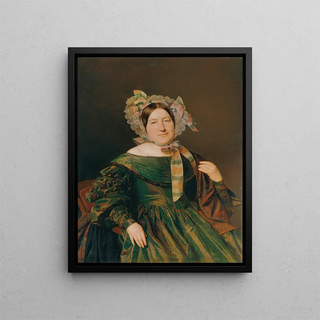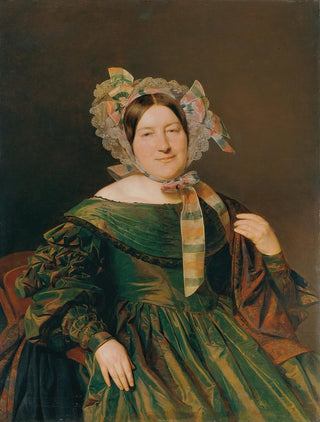Art print | Woman in iridescent salmon-red green dress - Ferdinand Georg Waldmüller


View from behind

Frame (optional)
"Femme en robe verte saumon-rouge irisée" by Ferdinand Georg Waldmüller stands as a vibrant testament to 19th-century art, where romantic sensitivity blends with a meticulous observation of human nature. The artwork, marked by remarkable delicacy and finesse, transports us to a world where beauty and elegance intertwine. The depicted woman, with her shimmering gown, seems to embody the very essence of femininity, while also evoking a certain melancholy. Waldmüller, through this piece, manages to capture a fleeting moment, an emotion suspended in time, inviting the viewer to contemplate the depth of the human soul.
Style and uniqueness of the artwork
Waldmüller's style is distinguished by its striking realism and its ability to pay homage to the beauty of everyday life. In "Femme en robe verte saumon-rouge irisée," the chosen color palette is both bold and harmonious, highlighting the iridescent reflections of the dress that seem to dance in the light. The meticulous details, from the folds of the gown to the delicate expressions on the face, demonstrate undeniable technical mastery. This painting is not limited to a simple representation; it also evokes a story, a hidden narrative behind the woman's contemplative gaze. The composition, carefully balanced, draws the eye toward the center of the work, while leaving room for the viewer's imagination to wonder about the thoughts of the protagonist.
The artist and his influence
Ferdinand Georg Waldmüller, an emblematic figure of Austrian Romanticism, left a lasting mark on his era through his innovative approach to genre and portrait painting. Born in 1793, he was influenced by the artistic currents of his time, while developing a personal style that was uniquely his own. Waldmüller often explored themes of daily life, highlighting human emotions through intimate scenes. His impact on Austrian art is undeniable, inspiring many artists to move away from academic conventions.

Matte finish

View from behind

Frame (optional)
"Femme en robe verte saumon-rouge irisée" by Ferdinand Georg Waldmüller stands as a vibrant testament to 19th-century art, where romantic sensitivity blends with a meticulous observation of human nature. The artwork, marked by remarkable delicacy and finesse, transports us to a world where beauty and elegance intertwine. The depicted woman, with her shimmering gown, seems to embody the very essence of femininity, while also evoking a certain melancholy. Waldmüller, through this piece, manages to capture a fleeting moment, an emotion suspended in time, inviting the viewer to contemplate the depth of the human soul.
Style and uniqueness of the artwork
Waldmüller's style is distinguished by its striking realism and its ability to pay homage to the beauty of everyday life. In "Femme en robe verte saumon-rouge irisée," the chosen color palette is both bold and harmonious, highlighting the iridescent reflections of the dress that seem to dance in the light. The meticulous details, from the folds of the gown to the delicate expressions on the face, demonstrate undeniable technical mastery. This painting is not limited to a simple representation; it also evokes a story, a hidden narrative behind the woman's contemplative gaze. The composition, carefully balanced, draws the eye toward the center of the work, while leaving room for the viewer's imagination to wonder about the thoughts of the protagonist.
The artist and his influence
Ferdinand Georg Waldmüller, an emblematic figure of Austrian Romanticism, left a lasting mark on his era through his innovative approach to genre and portrait painting. Born in 1793, he was influenced by the artistic currents of his time, while developing a personal style that was uniquely his own. Waldmüller often explored themes of daily life, highlighting human emotions through intimate scenes. His impact on Austrian art is undeniable, inspiring many artists to move away from academic conventions.






